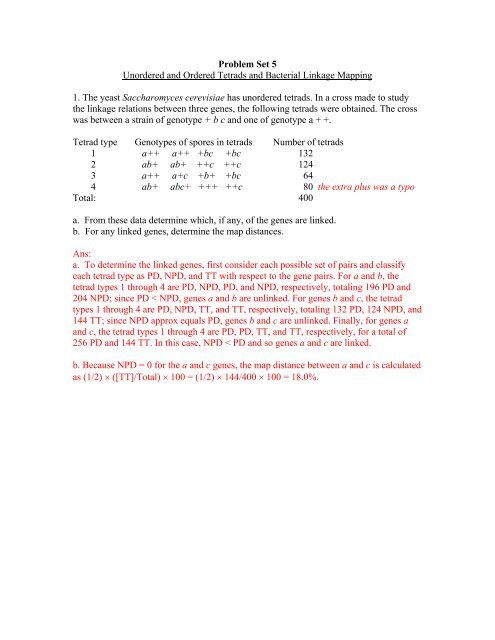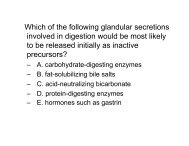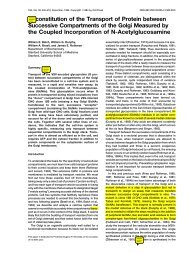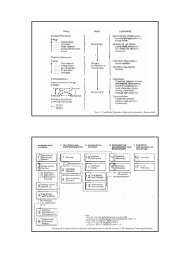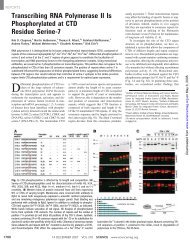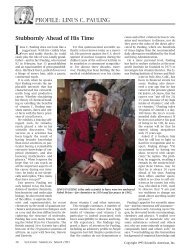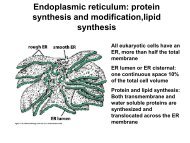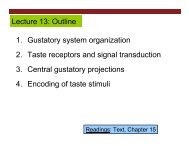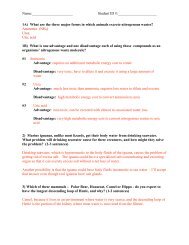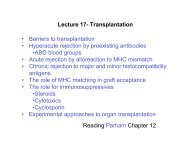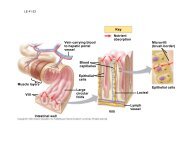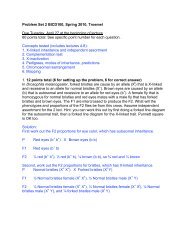Problem Set 5
Problem Set 5
Problem Set 5
You also want an ePaper? Increase the reach of your titles
YUMPU automatically turns print PDFs into web optimized ePapers that Google loves.
<strong>Problem</strong> <strong>Set</strong> 5<br />
Unordered and Ordered Tetrads and Bacterial Linkage Mapping<br />
1. The yeast Saccharomyces cerevisiae has unordered tetrads. In a cross made to study<br />
the linkage relations between three genes, the following tetrads were obtained. The cross<br />
was between a strain of genotype + b c and one of genotype a + +.<br />
Tetrad type Genotypes of spores in tetrads Number of tetrads<br />
1 a++ a++ +bc +bc 132<br />
2 ab+ ab+ ++c ++c 124<br />
3 a++ a+c +b+ +bc 64<br />
4 ab+ abc+ +++ ++c 80 the extra plus was a typo<br />
Total: 400<br />
a. From these data determine which, if any, of the genes are linked.<br />
b. For any linked genes, determine the map distances.<br />
Ans:<br />
a. To determine the linked genes, first consider each possible set of pairs and classify<br />
each tetrad type as PD, NPD, and TT with respect to the gene pairs. For a and b, the<br />
tetrad types 1 through 4 are PD, NPD, PD, and NPD, respectively, totaling 196 PD and<br />
204 NPD; since PD < NPD, genes a and b are unlinked. For genes b and c, the tetrad<br />
types 1 through 4 are PD, NPD, TT, and TT, respectively, totaling 132 PD, 124 NPD, and<br />
144 TT; since NPD approx equals PD, genes b and c are unlinked. Finally, for genes a<br />
and c, the tetrad types 1 through 4 are PD, PD, TT, and TT, respectively, for a total of<br />
256 PD and 144 TT. In this case, NPD < PD and so genes a and c are linked.<br />
b. Because NPD = 0 for the a and c genes, the map distance between a and c is calculated<br />
as (1/2) × ([TT]/Total) × 100 = (1/2) × 144/400 × 100 = 18.0%.
2. In yeast Saccharomyces cerevisiae the “gender” of the gametes is determined by a<br />
single gene, the mating type (mat) gene. Haploids are either type a or type α (equivalent<br />
of male and female) depending on which allele they have, and diploids are heterozygous<br />
a/α. Therefore in the cross mat-a met2 x mat-α arg7, three genes are heterozygous<br />
(mat, met2 and arg7). Two of these genes are linked and one is unlinked. Determine the<br />
map for the linked genes from the following unordered tetrads:<br />
Tetrad genotypes number of tetrads<br />
a met2 arg+ 119<br />
a met2 arg+<br />
α met+ arg7<br />
α met+ arg7<br />
a met+ arg+ 125<br />
a met+ arg+<br />
α met2 arg7<br />
α met2 arg7<br />
a met2 arg+ 33<br />
a met2 arg7<br />
α met+ arg+<br />
α met+ arg7<br />
a met+ arg+ 27<br />
a met+ arg7<br />
α met2 arg+<br />
α met2 arg7<br />
Answer:<br />
Tetrad mat/met mat/arg met/arg<br />
I = 119 PD PD PD<br />
II = 125 NPD PD NPD<br />
III =33 PD TT TT<br />
IV = 27 NPD TT TT<br />
PD = NPD PD>T>NPD PD=NPD<br />
conclusion: unlinked linked unlinked<br />
mat - arg = ½ TT / Total x 100 = [0.5(33 + 27)/(119 + 125 + 33 +27)] x 100 = 9.87 cM
3. In Neurospora, the following ordered tetrads were obtained for gene A near the<br />
centromere. What is the distance in map units of A from the centromere?<br />
A A a a 131 FDS<br />
a a A A 127 FDS<br />
A a A a 23 SDS<br />
a A a A 19 SDS<br />
Total: 300<br />
The two mitotic daughters are not indicated because they are identical, so the eight spores<br />
would be:<br />
A A A A a a a a, etc.<br />
Distance from centromere is ½ SDS x 100 = ½ (23+19) x100 = 7 cM<br />
Total 300
4. A small portion of the genetic map of Neurospora crassa chromosome VI is illustrated<br />
here. The cys-1 mutation blocks cysteine synthesis, and the pan-2 mutation blocks<br />
pantothenic acid synthesis. In a cross of cys-1 pan-2 ◊ CYS-1 PAN-2, what are the<br />
expected frequencies of the following types of asci, assuming complete chromosome<br />
interference?<br />
a. First-division segregation of cys-1 and first-division segregation of pan-2.<br />
b. First-division segregation of cys-1 and second-division segregation of pan-2.<br />
c. Second-division segregation of cys-1 and first-division segregation of pan-2.<br />
d. Second-division segregation of cys-1 and second-division segregation of pan-2.<br />
e. Parental ditype, tetratype, and nonparental ditype tetrads?<br />
Ans: The gene-centromere map distance equals 1/2 the frequency of second-division<br />
segregation, which also equals the frequency of crossing over in the region. In this<br />
problem it is easiest to answer the problem by taking the cases out of order, considering<br />
the second-division segregations at the beginning.<br />
c. The frequency of second-division segregation of cys-1 must be 14%, since the map<br />
distance is 7 cM. Because of the complete interference, a crossover on one side of the<br />
centromere precludes a crossover on the other side, and so these asci must have firstdivision<br />
segregation for pan-2.<br />
b. Similarly, the frequency of second-division segregation of pan-2 must be 6%, since the<br />
map distance is 3 cM; these asci must have first-division segregation for cys-1.<br />
d. Because of the complete interference, second-division segregation of both markers is<br />
not possible.<br />
a. The only remaining possibility is first-division segregation of both markers, which<br />
must have a frequency of 1 - 0.14 - 0.06 = 80%.<br />
e. First-division segregation of both markers yields a PD tetrad and second-division<br />
segregation for one of the markers yields a TT tetrad. Since there are no double<br />
crossovers, there can be no NPD tetrads. Hence, the frequencies are PD = 80% and TT =<br />
20%.
5. Challenge <strong>Problem</strong>:<br />
From the map below, predict the type and number of tetrads from the cross a leu1 x a<br />
his4. Assume you recover 900 tetrads.<br />
mat his leu<br />
_|____________|_________________|__<br />
10.5 15.4<br />
The cross is a leu1 his+ x α leu+ his 4:<br />
α his4 leu+<br />
a his+ leu1<br />
region 1 region 2<br />
Four events can occur:<br />
1 no recombination<br />
2 a single recombination event in region 1<br />
3 a single recombination event in region 2<br />
4 two recombination events, one in region 1 and the other in region 2<br />
#1 will produce a parental ditype = Tetrad I<br />
#2 will produce a tetratype in which mat changes linkage = Tetrad II<br />
#3 will produce a tetratype in which leu changes linkage = Tetrad III<br />
#4 will produce a tetratype in which his changes linkage = Tetrad IV<br />
I II III IV<br />
no recomb recomb region 1 recomb region 2 recomb regs 1 & 2<br />
a leu1 his+ a leu1 his+ a leu1 his+ a leu1 his+<br />
a leu1 his+ α leu1 his+ a leu+ his+ α leu1 his4<br />
α leu+ his4 a leu+ his4 α leu1 his4 α leu+ his+<br />
α leu+ his4 α leu+ his4 α leu+ his4 α leu+ his4<br />
The distance between two genes is<br />
cM = 0.5 [ (single XO’s + double XO’s) / total ] x 100<br />
Therefore the total number of recombination events occurring between two loci<br />
whose distance is known is derived by simple algebra from the mapping formula:<br />
Total XO’s = single XO’s + double XO’s = 2 [ (cM x total) / 100 ]<br />
This tells us the total number of recombinants, but to get the number of singles,<br />
we must subtract the doubles. The doubles must be calculated independently.<br />
cM expresses the probability of a recombination event. If two recombinations are<br />
independent of one another, then the number of double recombinants can be<br />
calculated by determining the product of their independent probabilities and<br />
multiplying by the total.
double XO’s = 2 [ (cM reg 1) / 100 ] x [ (cM reg 2) / 100] x total<br />
This will give the number of tetrads showing the IV pattern. (The factor of 2 in the<br />
equation is derived from the 1/2 that we use when dealing with tetrads.) Now, the<br />
total number of single recombinations between two loci can be calculated, giving<br />
the numbers of II and III tetrads. All that is left is to calculate the number of non<br />
recombinants:<br />
Total Tetrads = I + II + III + IV<br />
double XO’s = tetrad IV = 2 [(10.5 / 100)] x [(15.4 / 100)] x 900 = 29<br />
single XO’s in region 1 = tetrad II = 2 [ (10.5 x 900) / 100 ] - 29 = 160<br />
single XO’s in region 2 = tetrad III = 2 [ (15.4 x 900) / 100 ] - 29 = 248<br />
non recombinants = tetrad I = 900 - 160 - 248 - 29 = 463


